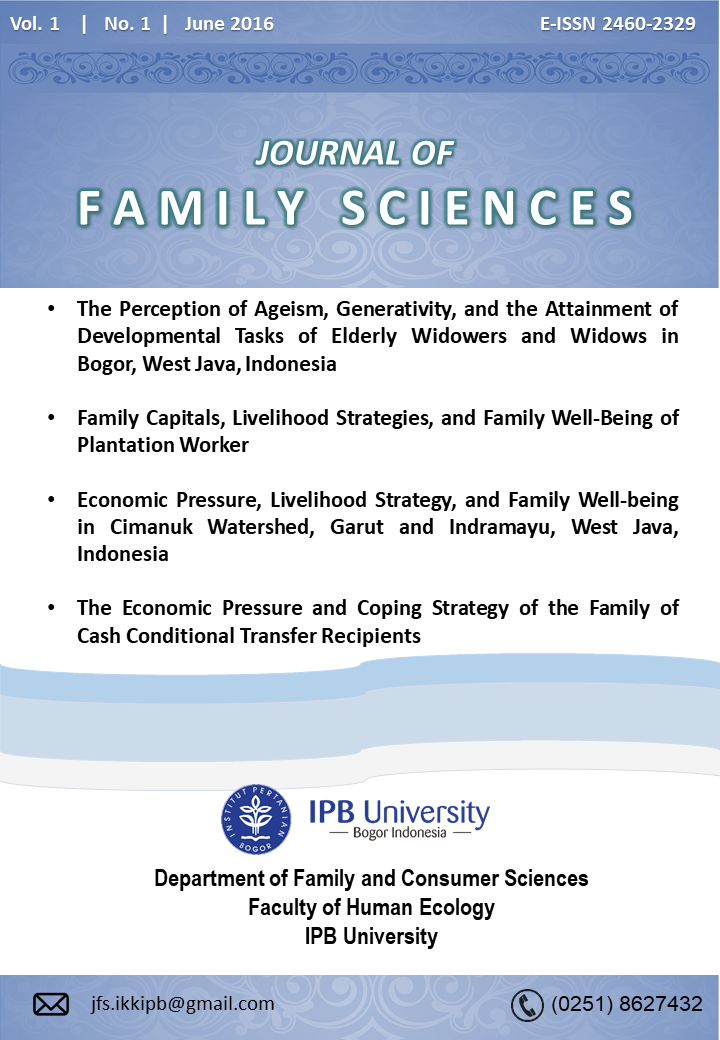Economic Pressure, Livelihood Strategy, and Family Well-being in Cimanuk Watershed, Garut and Indramayu, West Java, Indonesia
Abstract
The objective of this study is to analyze economic pressure, livelihood strategy, and well-being of families in Cimanuk Watershed. This study used a cross-sectional study design. As many as 72 samples of lower middle class families (determined by Poverty Line of BPS 2013) who have toddler and school age children were chosen puposively. This study was conducted in Garut District and Indramayu District. The results showed that inspite of being in poverty, only one out of three families felt highly economic pressure, and one out of ten families perceived poorly well-being. Family economic pressure was affected by the region difference, education level of father, and ownership of financial capital. Meanwhile, family well-being was affected by the education level of the father, financial capital, social capital, access to the environment, economic pressure, and livelihood diversification. Livelihood diversification is the strategy that most poor families did in Cimanuk Watershed. Livelihood diversification of families was affected by the age of the wife, expenditure per capita, social capital, and access to the environment.
Downloads
References
Belcher, B., Bastide, F., Castella, J. C., & Boissiere, M. (2012). Development of a village-level livelihood monitoring tool: A case-study in Viengkham District, Lao PDR. International Forestry Review, 14(4).
Carswell, G. (1997). Agricultural intensification and rural sustainable livelihoods: A ‘think piece’ (Working Paper 64). Retrieved from https://www.ids.ac.uk/files/dmfile/Wp64.pdf.
Chambers, R., & Conway, G. R. (1991). Sustainable rural livelihoods: Practical concepts for 21st century. IDS Discusions paper 296. Retrieved from https://www.ids.ac.uk/files/Dp296.pdf.
Chambers, R. (1995). Poverty and livelihoods: Whose reality counts?. Environment and Urbanization, 7(1), 173-204. doi: 10.1177/095624789500700106.
Department for International Development. (1999). Sustainable livelihoods guidance sheet. Retrieved from http://www.eldis.org/vfile/upload/1/document/0901/section2.pdf.
Dharmawan, A. H. (2007). Sistem penghidupan dan nafkah pedesaan: Pandangan sosiologi nafkah (livelihood sociology) mazhab Barat dan mazhab Bogor [Livelihood and rural livelihood systems: Livelihood sociology of Western ideology and Bogor ideology]. Sodality: Jurnal Transdisiplin Sosiologi, Komunikasi, dan Ekologi Manusia, 1(2), 169-192. Retrieved from http://journal.ipb.ac.id/index.php/sodality/article/view/5932/4609.
Elder, G. H., Jr., Conger, R. D., Foster, E. M., & Ardelt, M. (1992). Family under economic pressure. Journal of Family Issues, 3(1), 5-37. doi: 10.1177/019251392013001002
Elder, G. H., Jr., Eccles, J. S., Ardelt, M., & Lord, S. (1995). Inner-city parents under economic pressure: Perspectives on the strategies of parenting. Journal of Marriage and the Family, 57, 771-784.
Ellis, F. (1999). Rural livelihood diversity in developing countries: Evidence and policy implications. Journal London Overseas Development Institute.
Ellis, F. (2000). The determinants of rural livelihood diversification in developing countries. Journal of Agricultural Economic, 51(2), 289-302. doi: 10.1111/j.1477-9552.2000.tb01229.x.
Farrington, J., Ramasut, T., & Walker, J. (2002). Sustainable livelihood approaches in urban areas (Working Paper No. 162). Retrieved from http://www.odi.org/sites/odi.org.uk/files/odi-assets/publications-opinion-files/2706.pdf.
Food and Agriculture Organization of the United Nations, & International Labour Organization. (2009). The Livelihood Assessment Tool-Kit: Analysing and Responding to the Impact of Disasters on the Livelihoods of People (1st ed.). Roma & Geneva: Authors.
Frankenberger, T. R., Luther, K., Becht, J., & Katherine. (2002). Household Livelihood Security Assessments: A Toolkit for Practitioners. Tucson, AZ: Tango International, Inc.
Hartoyo. (2009). Pemberdayaan Ekonomi Keluarga Dalam Rangka Peningkatan Ketahanan Keluarga (Families Economic Empowerment in the Context of Family Resilience Enhancement). In E. Sunarti (Ed.), Naskah Akademis Pengembangan Model Ecovillage: Pengembangan Kawasan Pedesaan serta Peningkatan Sumbangan Pertanian dalam Peningkatan Kualitas Hidup Penduduk Pedesaan (Academic Development Model Ecovillage: Rural Area Development and Improvement of Agriculture's Contribution in the Life Quality Improvement of Rural Population) (pp. 207-233). Bogor, Indonesia: Lembaga Penelitian dan Pengabdian kepada Masyarakat (LPPM IPB).
Hartoyo, Djamaludin, M. D., & Herawati, T. (2013). Transfer kemiskinan antar generasi di wilayah agroekologi yang berbeda: perdesaan dan perkotaan. Prosiding Seminar Hasil-Hasil PPM IPB 2013. 22, 682-697.
Ihsannudin, & Wijayanti, L. (2013). Strategi peningkatan kesejahteraan masyarakat nelayan Kecamatan Pademawu Kabupaten Pamekasan (The strategy for improving the welfare of fishermen at Pademawu Sub-District, Pamekasan Regency). Jurnal Agriekonomika, 2(2), 149-189. Retrieved from http://journal.trunojoyo.ac.id/agriekonomika/article/view/433/404.
Iskandar, Hartoyo, Sumarwan, U., & Khomsan, A. (2006). Faktor faktor yang mempengaruhi kesejahteraan keluarga (Factors that affect family well-being). Hasil Penelitian, 133-141. Retrieved from http://repository.usu.ac.id/bitstream/123456789/18931/1/ikm-des2006-10%20(9).pdf.
Kamarrudin, R., & Samsudin, S. (2014). The sustainable livelihoods index: A tool to assess the ability and preparedness of the rural poor in receiving entrepreneurial project. Journal of Social Economic Research, 1(6), 108-117.
Ministry of Environment. DAS Cimanuk [Cimanuk Watershed]. Retrieved from http://ppejawa.com/ekoregion/das-cimanuk/.
Ministry of Public Works. (2010). Pengelolaan Sumber Daya Air Sungai Cimanuk-Cisanggarung [Water resource management in Cimanuk River-Cisanggarung]. Jakarta, Indonesia: Author.
Lestari, D. V. (2012). Dinamika pembangunan masyarakat Kabupaten Garut 1993-2008 [The dynamics of community development Garut 1993-2008]. Student E-Journals Universitas Padjajaran, 1(1). Retrieved from http://jurnal.unpad.ac.id/ejournal/article/view/1755/1771.
Moser, C. (2005). Asset, Livelihoods and Social Policy, Arusha Conference, “New Frontiers of Social Policy”, Arusha, December 12-15.
Puspitawati, H. (2012). Gender dan Keluarga: Konsep dan Realita di Indonesia [Gender and Family: Concept and Reality in Indonesia]. Bogor, Indonesia: IPB Press.
Puspitawati, H., & Herawati. (2013). Metode Penelitian Keluarga [Family Research Method]. Bogor, Indonesia: IPB Press.
Robila, M. (2006). Economic pressure and social exclusion in Europe. The Social Science Journal, 43(1), 85–97. doi:10.1016/j.soscij.2005.12.009.
Saragih, Lassa, J., & Ramli, A. (2007). Sustainable livelihood framework. Retrieved from http://www.zef.de/module/register/media/2390_SL-Chapter1.pdf.
Scoones, I. (1998). Sustainable rural livelihoods: A framework for analysis (Working Paper 72). Retrieved from http://www.ids.ac.uk/publication/sustainable-rural-livelihoods-a-framework-for-analysis.
Scoones, I. (2009). Livelihoods perspectives and rural development. Journal of Peasant Studies, 36(1), 171-196. doi: 10.1080/03066150902820503.
Statistics Indonesia. (2008). Analisis dan Penghitungan Tingkat Kemiskinan 2008 [Analysis and Calculation of Poverty Level in 2008]. Jakarta, Indonesia: Author.
Statistics Indonesia. (2012). Analisis Data Kemiskinan Berdasarkan Data Pendataan Program Perlindungan Sosial (PPLS) 2011 [Poverty Data Analysis Based on Data Collection of Data Social Protection Program 2011]. Jakarta, Indonesia: Author.
Su, F., & Shang, H. (2012). Relationship analysis between livelihood assets and livelihood strategies: A Heihe River Basin example. Sciences in Cold and Arid Regions, 4(3), 0265-0274. doi: 10.3724/SP.J.1226.2012.00265.
Sulaksana, N., Sukiyah, E., Sjafrudin, A., & Haryanto, E. T. (2013). Karakteristik geomorfologi DAS Cimanuk bagian hulu dan implikasinya terhadap intensitas erosi serta pendangkalan Waduk Jatigede (Cimanuk Watershed geomorphological characteristics of the upstream and the implications for the intensity of erosion and silting Jatigede). Bionatura Jurnal Ilmu- ilmu Hayati dan Fisik, 15(2), 100-106. Retrieved from http://jurnal.unpad.ac.id/bionatura/article/view/7203.
Sunarti, E., & Firdaus, M. (2009). Hubungan antara tekanan ekonomi dan mekanisme koping dengan kesejahteraan keluarga wanita pemetik teh (The relationship between economic stress and coping mechanisms with family well-being of women tea pickers). Jurnal Ilmu Keluarga dan Konsumen, 2(1), 21-31.
Sunarti, E., Tati, Atat, S. N., Noorhaisma, R., & Lembayung, D. P. (2005). Pengaruh tekanan ekonomi keluarga, dukungan sosial, kualitas perkawinan, pengasuhan, dan kecerdasan emosi anak terhadap prestasi belajar anak (Influence of family economic pressure, social support, quality of marriage, parenting, and child emotional intelligence on child academic achievement). Media Gizi & Keluarga, 29(1), 34-40.
Wahyudi, H., & Sismudjito. (2007). Strategi adaptasi sosial ekonomi keluarga miskin pasca kenaikan harga bahan bakar minyak (BBM) (Socioeconomic adaptation strategies of poor families after the increase in fuel prices). Jurnal Harmoni Sosial, 1(2), 83-95. Retrieved from http://repository.usu.ac.id/bitstream/123456789/18583/1/har-jan2007-1%20(1).pdf.
Widiyanto, Setyowati, R., & Suwarto. (2010). Dinamika nafkah rumah tangga petani pedesaan dengan pendekatan sustainable livelihood approach (SLA) (The dynamics of rural farmers household income with sustainable livelihood approach). Jurnal Agritext . No 28.
Widodo, S. (2011). Strategi nafkah berkelanjutan bagi rumah tangga miskin di daerah Pesisir. Makara, Sosial Humaniora, 15(1), 10-20.
Authors who publish with this journal agree to the following terms:
- Authors retain copyright and grant the journal right of first publication with the work simultaneously licensed under a Creative Commons Attribution 4.0 International License that allows others to share the work with an acknowledgement of the work's authorship and initial publication in this journal.
- Authors are able to enter into separate, additional contractual arrangements for the non-exclusive distribution of the journal's published version of the work (e.g., post it to an institutional repository or publish it in a book), with an acknowledgement of its initial publication in this journal.
- Authors are permitted and encouraged to post their work online (e.g., in institutional repositories or on their website) prior to and during the submission process, as it can lead to productive exchanges, as well as earlier and greater citation of published work (See The Effect of Open Access).



_001.png)











